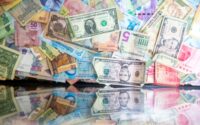Argentina is set to raise interest-rates to 97%
Over the weekend I was thinking about Turkey and the issues of high interest-rates and currency devaluations, partly due to the Presidential elections there. But in terms of economic news Argentina has stepped up and said “Hold My Beer”.
Argentina is preparing a set of emergency measures, including raising its key interest rate by 600 basis points to 97 percent on Monday, as inflation spirals out of control in the run up to presidential elections, according to officials at the Economy Ministry and the Central Bank. ( Bloomberg)
The first impact is that today’s move will be larger than the total moves so far by and of the major world central banks, which in themselves have been a big deal. Then we note the new level of 97% which is both hot and rather chilling at the same time. Next up we can note that the last move was quite recent and was even larger as we look back less than a month to the 27th of April.
The Board of Directors of the Central Bank of the Argentine Republic (BCRA) decided today to raise the monetary policy rate by 1,000 basis points. In this way, the annual nominal interest rate of the 28-day Liquidity Bills (Leliq) increased to 91% (141% in effective annual terms, TEA).
So back then the move was even larger! We also need to note how quickly the impact of a 10% increase in interest-rates faded. So this is a crisis and one immediately starts wondering about the extremes of Weimar and Zimbabwe. Also, whoever has the job of presenting this at the Bank of England morning meeting may well rather discombobulate the Governor and if she is there the policymaker from Argentina Silvana Tenreyro who as it happens who is no fan of interest-rate rises.
Why?
If we start with the question posed by Carly Simon and look for a short-term trigger then we only need to look back to Friday.
BUENOS AIRES, May 12 (Reuters) – Argentina’s annual inflation rate soared to 109% in April, the country’s statistics agency said on Friday, smashing past analyst forecasts and stoking anger among hard-hit consumers who are increasingly having to skimp and save to get by.The South American nation, an important grains exporter and the region’s no. 2 economy, posted 8.4% monthly inflation in April, well above analyst forecasts of 7.5% and the highest in decades. That took the 12-month rate to an eye-watering 108.8%.
Again thoughts turn to the Weimar Republic.
“When I came last time (to the market), I paid 300 pesos a kilo for bell peppers – it’s 300 pesos a half kilo now,” said Olivia Maria Belbruno, 70, a retiree.
The official release does not breakdown food inflation bit overall it was running at 10.1% for the month. This must be especially galling in a country which is a food exporter.
The Argentine Peso
According to the Buenos Aires Times things are in quite a pickle.
Argentina’s fight to prevent its problematic currency from a total meltdown is leaving the Central Bank, by some estimates, broke.
The nation has already spent all of its liquid international reserves, plus another estimated US$1 billion, according to Buenos Aires-based consulting firm 1816 Economía & Estrategia — raising the stakes as the nation contends with a historic drought and impending recession.
We have seen before that a drawndown of reserves can have quite an impact even if you have a decent chunk left. But estimates of zero are in another league. Officially we are told some US $34 billion is there but much of that is illiquid being in Gold or at the IMF. Or in a sign of the times a swap line with China.
As we look further there has been intervention.
In just the past week, the Central Bank sold about US$470 million to support the currency in parallel markets, said Fernando Marull, an economist at Buenos Aires-based consultancy FMyA.
But at best it is slowing the fall.
It’s been difficult to measure the success of the government’s intervention. The unofficial peso lost about 13 percent against the US dollar last month, and is down 33 percent so far this year, by far the biggest decline in key emerging markets.
Actually I think the success is pretty clear, but each to their own. If we look for the exchange-rate it has not opened yet today but it closed at 229 versus the US Dollar which is some 95% lower than a year ago so we are in Paul Simon territory.
Slip slidin’ away
Slip slidin’ away
You know the nearer your destination
The more you’re slip slidin’ away
If you look at the chart you can see the intervention as the central bank looks like it tries to move in 0.5 Peso steps. Although it was obviously under more pressure on the 8th and saw a larger move. But the underlying theme is that as you might expect with the size of the inflation rate it has been currency driven.
There is also an unofficial rate which we have looked at before and on Friday it was around 470 so a bit more than double the official rate. It is called the blue Peso.
The US Dollar
This has a role in Argentina due to the situation above as for some it is the effective currency. Of course that is likely to be amongst the better-off mostly but it has implications beyond Argentina.
Argentine savers have an estimated $200 billion USD in paper dollars, which means that the country owns 10% of total physical dollar bills and 20% of physical dollars outside of the United States ( @BowTiedMara)
Remember these are cash holdings not counting the electronic dollars but even so, as the same source continues.
The dollar as a store of value to flee from the peso is so significant that in Argentina there are more physical dollars per capita than in the issuing country itself, the United States : 4400 USD/capita.
The International Monetary Fund
This has been involved for quite some time. Regular readers will recall that back on the 2nd of September 2019 I noted that the then IMF Managing Director of the IMF Christine Lagarde had said things in Argentina were “bearing fruit”. Whereas I put it like this back then.
Yet the largest ever IMF programme she left behind continues to fold like a deckchair.
Since then things have gone like this.
2018, Argentina got a $57bn bailout from IMF. Argentina was due to repay IMF $19bn in 2022 under the terms of the original deal, including a $2.8bn instalment due in March, but didn’t have enough. 2022, Argentina secured a $45bn deal with IMF to restructure the $57bn loan.
That can kicking of the debt has echoes of what happened with Greece which of course was something else that Christine Lagarde was involved with.
Comment
This has spiraled even further out of control and regular readers will also recall this from January 23rd.
Brazil and Argentina will this week announce that they are starting preparatory work on a common currency, in a move which could eventually create the world’s second-largest currency bloc.
Brazil must be quietly pressing the delete button on that. Anyway as I pointed out at the time it would not achieve its claimed goal.
However the going them gets a lot tougher because the impact on the US Dollar would overall be zero. Rather than paying in Real’s or Peso’s they would be paying in Sur’s so no change.
But what it have us was a warning of how desperate Argentina was and is. Another signal is going to the Chinese.
Economy minister Sergio Massa is also trying to persuade the IMF to bring forward the disbursement of agreed loans and will travel to China on May 29 to seek greater use of the renminbi in foreign trade. Last month, Argentina activated a currency swap with China allowing it to pay just over $1bn of its imports this month in renminbi. ( Financial Times)
Combining China and the IMF seems quite a toxic mixture in itself.
Next up is the Argentine government which has done this.
The latest package of measures does not represent a change of course, more an attempt to reiterate policies of heavy state intervention which have failed to bring down inflation or boost the economy………Fuelled by money-printing to finance a large government deficit, ( Financial Times)
This must be dreadful for the ordinary Argentine. Football success has not be accompanied by an economic boom but exactly the opposite.
Podcast
[ad_2]
Source link


